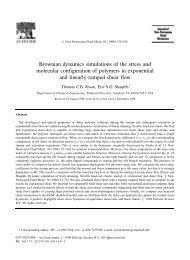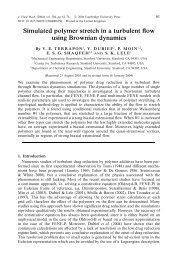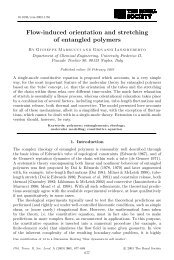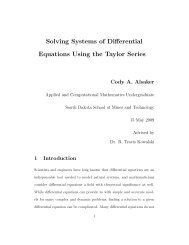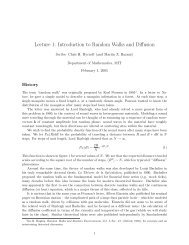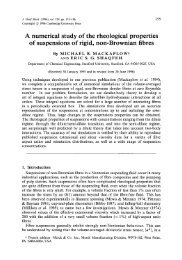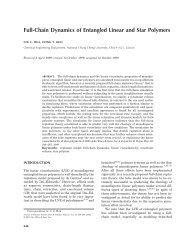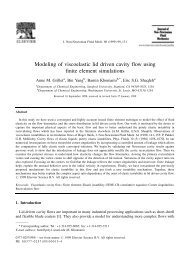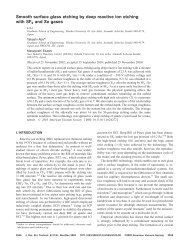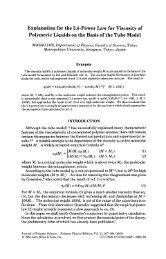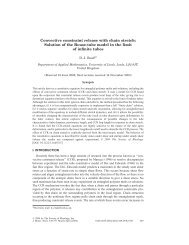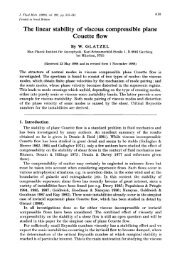Molecular modelling of entangled polymer fluids under flow The ...
Molecular modelling of entangled polymer fluids under flow The ...
Molecular modelling of entangled polymer fluids under flow The ...
Create successful ePaper yourself
Turn your PDF publications into a flip-book with our unique Google optimized e-Paper software.
2.3. DOI-EDWARDS MODEL OF ENTANGLED POLYMERS 25<br />
<strong>The</strong> constant <strong>of</strong> proportionality, G 0 , relating the stress to the fraction <strong>of</strong> unrelaxed<br />
tube is called the plateau modulus. <strong>The</strong> concept is generalised from calculation <strong>of</strong> the<br />
modulus in a cross-linked network. <strong>The</strong> plateau modulus is related to the molecular<br />
parameters by<br />
G 0 = 4 ρRT<br />
. (2.31)<br />
5 M e<br />
<strong>The</strong> experimental value <strong>of</strong> the plateau modulus is <strong>of</strong>ten used as a method <strong>of</strong> determining<br />
M e , or equivalently the tube diameter. This can be problematic since the experimental<br />
plateau in G ′ (ω) is only independent <strong>of</strong> chain length in the limit <strong>of</strong> very highly <strong>entangled</strong><br />
materials. For example see figure 2.8(b). <strong>The</strong> plateau can be seen by eye since data<br />
are available on an exceptionally well <strong>entangled</strong> material (Z ≈ 44). However, it would<br />
be less clear if the data for the higher molecular weight melts were not available. <strong>The</strong><br />
factor <strong>of</strong> 4/5 arises because the entanglements allows longitudinal motion <strong>of</strong> the chain<br />
along the tube to relax stress. <strong>The</strong> proportion <strong>of</strong> stress relaxed in this way is 1/5 <strong>of</strong><br />
the total stress and in this sense entanglements are distinct from crosslinks since this<br />
longitudinal motion is not possible in crosslinked systems. This factor has resulted in<br />
wide spread confusion and contradiction. For an explanation and a proposed solution<br />
to this see Likhtman and McLeish (2002). I will adopt their conventions in this thesis.<br />
In particular the definition <strong>of</strong> the entanglement modulus G e = σ xy (τ e )/γ, the relaxation<br />
modulus a t = τ e after a small step shear is safer. This is directly equivalent to the<br />
cross linked version since no relaxation on length-scales longer than the tube diameter<br />
will have occurred. In terms <strong>of</strong> the molecular parameters G e is given by<br />
G e = ρRT<br />
M e<br />
. (2.32)<br />
Equation 2.30 demonstrates the strong influence <strong>of</strong> entanglements on the chain<br />
dynamics, in that it they increase the characteristic relaxation time by a factor <strong>of</strong><br />
3Z. <strong>The</strong> above result can also be derived directly by solving a microscopic Langevin<br />
equation as in the derivation <strong>of</strong> the Rouse model (see section 2.4.1).<br />
<strong>The</strong> relaxation spectrum derived above can be used with equation 1.14 to produce<br />
predictions for the complex modulus <strong>of</strong> a linear <strong>polymer</strong> fluid <strong>under</strong> linear oscillatory<br />
shear.<br />
<strong>The</strong>se model predictions, together with some experimental data on a range<br />
<strong>of</strong> nearly monodisperse polystyrene melts are shown in figure 2.8.<br />
<strong>The</strong> qualitative<br />
similarities between the theory and data are very encouraging. Both sets show a plateau<br />
region in G ′ , that increases in width with molecular weight. In both cases the plateau<br />
height is independent <strong>of</strong> molecular weight. <strong>The</strong> experimental data show an upturn at<br />
high frequencies that is not present in the theory. This can be rectified by taking into<br />
account the free Rouse motion <strong>of</strong> the chain at length-scales which are shorter than the<br />
tube diameter. Similar qualitative agreement can be seen for G ′′ (ω).



